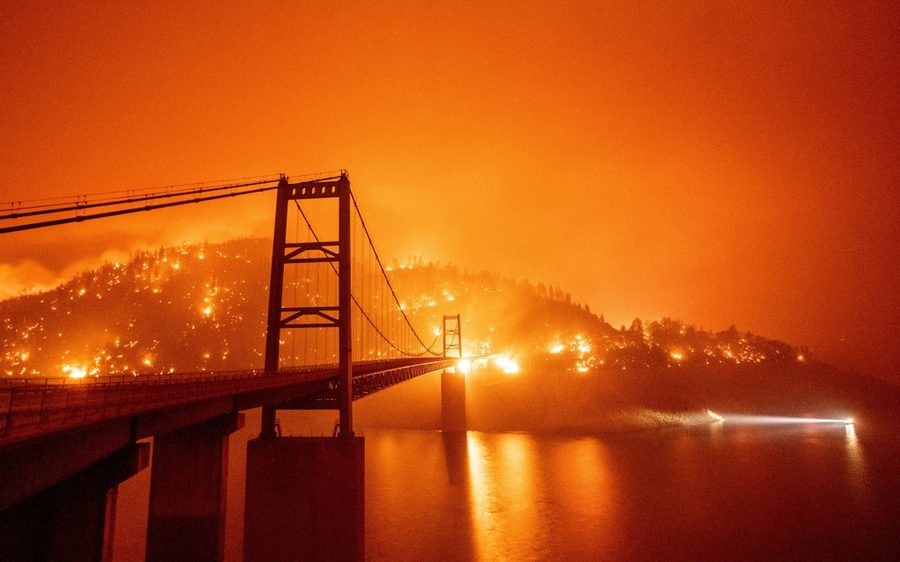
From derechos in Iowa to dueling hurricanes in the Gulf Coast, 2020 is promising to be an election year shot through with climate disasters. Even now, raging wildfires have spawned apocalyptic landscapes from Washington State on down to the Bay Area.
In style and substance, there are few issues on which the two major parties are as far apart as climate change.
The Republicans have become the official party of climate denialism. The Trump administration has routinely censored climate science and gutted common sense, often life-saving regulations to benefit the fossil fuel industry. Under Republican leadership, the U.S. has become the only country to quit the flawed but essential Paris climate accord.
The Democrats are distinctly better. They’ve rolled out a raft of different climate platforms and prominently campaigned on the issue. Grassroots movements have pushed the Biden campaign in particular to significantly increase the ambition of its commitments on climate.
But the real test of even a “better” platform is whether it keeps global warming to within 1.5 degrees Celsius above pre-industrial levels. The answer is a matter of life and death for billions, particularly the world’s most vulnerable people.
To go from merely “better than the Republicans” to “sufficient to save the planet,” the party needs to shift its thinking in several areas. Key among these are ending fossil fuel production, taking responsibility for U.S. emissions internationally, and humanely welcoming refugees impacted by climate change.
Fossil Fuel Blinders
The Democrats’ commitments are spelled out in a range of documents, including the House Select Committee on the Climate Crisis report, the Biden-Sanders Unity Task Force plan, the Biden campaign platform, the official Democratic party platform, and most recently, the Senate Democrats’ climate plan.
Broadly speaking, there’s a lot to commend in these platforms.
To start, it’s encouraging to see climate recognized as a major issue at all — and not just climate change, but climate justice. All of these platforms call for undoing legacies of environmental racism and injustice and centering frontline communities in solutions. This is a major step forward, won by decades of environmental justice organizing.
But the first big stumble is their failure to take on fossil fuel production. There’s growing scientific evidence that cutting fossil fuel consumption alone won’t be enough to avert climate catastrophe — we also need to phase out their production. That’s especially true for the U.S., the world’s largest producer of both petroleum and natural gas, and the third largest producer of coal.
None of the platforms make a hard commitment to do this. They call instead for baby steps, such as eliminating fossil fuel subsidies and cutting methane leaks. That’s necessary but far from sufficient, and they may already be backtracking. During the convention, the DNC quietly removed a plank calling for an end to fossil fuel subsidies, though the Biden campaign insists it remains committed to ending them.
Failing to address fossil fuel production seriously dilutes the commitment all the platforms make to environmental justice. Fossil fuel extraction, transportation, processing and burning have serious environmental, safety, and health impacts, particularly on marginalized communities. And even if we ended domestic consumption, these fuels could still be exported — and burned — abroad. That would allow the environmental justice impacts to continue, whether in extraction-affected communities at home or communities next to power plants and industrial facilities in other countries.
Instead of addressing this directly, the Democratic plans wish away emissions by invoking Carbon Capture and Storage (CCS), a largely unproven technology to “capture” carbon emissions from ongoing fossil fuel operations. The Biden platform, for example, calls to “accelerate the development and deployment” of the technology.
This is a dangerous delusion. CCS isn’t proven to work at scale — after years of research and development, there’s only one operational CCS facility in the United States. It’s also inordinately expensive, which could take resources away from scaling up proven solutions such as solar and wind energy, which are already cost-competitive with fossil fuels.
Even if one could capture carbon dioxide from smokestacks economically and at scale, those same smokestacks will still emit particulate matter and other dangerous pollutants. Communities exposed to these pollutants — disproportionately low-income people and communities of color — would continue being treated as sacrifice zones.
Of course, crafting a just plan to wind down fossil fuel production is hard work. It will need extensive input from impacted workers dependent on the industry for their livelihoods, and impacted communities dependent on tax revenues from the industry, to ensure a thriving future for them. But there’s no excuse not to do it.
Showing Responsibility, Not “Leadership”
The other major blind spot in these platforms is their narrow nationalism.
Greenhouse gases emitted by any one country effectively warm the entire planet. That’s why we have a U.N. Framework Convention on Climate Change (UNFCCC) process to deal with climate action as the inherently multilateral issue that it is. That’s why it was so irresponsible for Trump to walk away from the UNFCCC.
But rejoining the Paris accord isn’t nearly enough.
Greenhouse gas reduction targets under the Paris Climate Agreement are nonbinding, with countries making only voluntary pledges. The pledges made by all countries under the Paris accord would result in a 3.2 degree Celsius global average temperature increase, well over the 1.5 degrees upper limit scientists have shown we must stay within to preserve a livable planet.
At the 2020 Democratic convention, former Secretary of State John Kerry cast the Paris agreement as evidence of Barack Obama and Joe Biden’s global leadership. But it was the Obama administration itself that pressured the Paris signatories to make their commitments non-binding.
To their credit, the current crop of Democratic plans go beyond promising to rejoin the Paris Climate Agreement. But their continued insistence on putting the U.S. “back in the position of global leadership where we belong,” as the party platform promises, isn’t just hubristic nationalist rhetoric — it results in substantive shortcomings.
To start, none of the plans recognize that the U.S. has among the highest per capita emissions of any country, and an astonishing one quarter of cumulative emissions since roughly the start of the Industrial Revolution. Cumulative emissions matter, because carbon dioxide can persist in the atmosphere for centuries.
A more honest approach would be to speak not of America’s leadership but its responsibility to reduce its own emissions rapidly on a scale that matches its outsized contribution to global emissions.
Unfortunately, the U.S voluntary target barely exceeds a quarter of the most conservative estimate of what a fair share of emissions reductions by the U.S. should be. So when the Democratic Party platform says the U.S. will “seek higher ambition from nations around the world,” it’s fair to ask: Why not increase our own commitment first?
Instead, the party appears to blame other countries for the crisis. The Biden campaign platform claims that countries like China “game the system by becoming destination economies for polluters.” But China’s status as the world’s factory is in significant part attributable to the corporate-friendly global trade regime that the U.S. has consistently pushed for. China is our third largest trading partner, and U.S. companies are responsible for much of the pollution in China.
Then there’s the matter of the U.S. debt to countries impacted by our emissions.
The Democratic plans do commit the U.S. to the Green Climate Fund, which funds climate action in less wealthy countries. But absent specific monetary commitments, it’s an empty promise.
The U.S. pledge under the Obama administration, for example, was only $3 billion (Trump later reneged on $2 billion of this). This compares to an estimated need for worldwide capital investment of 810 billion Euros ($956 billion) by 2030 annually for bringing emissions down (“mitigation”), and another $500 billion by 2050 annually for adjusting to climate change impacts (“adaptation”). Given the outsized U.S. role in causing the climate crisis, it’s only fair that the U.S. contribution to global mitigation and adaptation costs should be orders of magnitude larger.
“Fortress America”
Finally, there’s the issue of migration. More than 140 million people are expected to be displaced by climate change in the coming decades. Any serious climate plan demands a humane approach to this wrenching crisis, which is already beginning to unfold.
To its credit, the official party platform commits to addressing “the root causes of migration,” including “the impacts of climate change.” But the Biden campaign, House Select Committee, and Senate Democrats’ plans, with their emphasis on “national security” and “preparing” at the border, hint vaguely at what’s sometimes called “Fortress America.”
Biden promises to “elevate climate change as a national security priority” in response to “defense and intelligence leaders’ warnings about the threats climate change poses to global stability.” He plans to make “security implications of resulting large-scale migrations” driven by climate change a subject of intelligence gathering.
Similarly, the House Select Committee wants federal agencies to “prepare for climate-driven internal and cross-border migration” in response to climate risks to national security, while the Senate plan warns that climate-driven migration will “strain state capacity, further fracture societies, and could create breeding grounds for radicalization.”
Almost as an afterthought, the Senate plan does recognize that “individuals whose lives are imminently threatened by climate change may have a legal basis for refugee protection,” though it stops short of affirming one itself. The Biden and House plans say nothing about climate-driven migration as a human rights issue.
Without a firm commitment to the human rights of climate refugees, these vague approaches could easily presage a militarized response to a crisis for which the U.S. is disproportionately responsible. The message to the rest of the world is: “We don’t care if our emissions parched your crops and displaced you — we’ll preserve our gated community.”
A more humane response would necessitate the U.S. opening its borders to people fleeing climate devastation, a core part of taking responsibility for the effects of its historical emissions.
The Strength of Our Movements
The Democrats have gotten a good deal stronger on climate justice in recent years. Still, their official positions often remain stuck in the Obama years, leaving the door open for an “all of the above” energy agenda at home, undermining more meaningful action in global climate talks, and barring the door to impacted refugees.
What they haven’t reckoned with is the strength of our movements for climate justice. It’s the strength of our movements that has forced the Democrats to acknowledge the primacy of environmental justice — and to differentiate the party more clearly from the denialist Republicans.
And it’s the strength of our movements that has decisively shifted the center of gravity of climate policy from a neoliberal “carbon pricing” approach to a focus on regulation, government spending, and social justice.
If a Democratic administration takes office in 2021, they can expect massive resistance to fossil fuels at home, and unrelenting pressure to abandon hubristic notions of “American leadership” and engage in good-faith in global climate action.
This article was produced in collaboration with Foreign Policy In Focus.
Basav Sen directs the Climate Policy Program at the Institute for Policy Studies.







